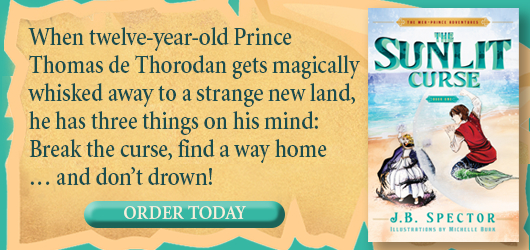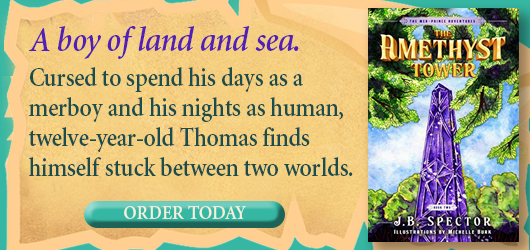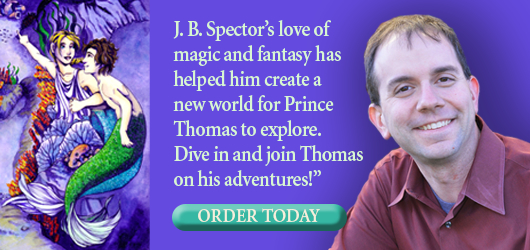It looks like you've stumbled upon a page meant to be read by our code instead of viewed directly. You're probably looking for this page.
An Interview with J.B. Spector, Author of The Mer Prince Adventures
If there’s one thing we’ve all come to appreciate over these past several months, it’s the power of escapism. Whether through books, movies, or television, we have all been living vicariously through art, longing for the day we can take our shelved plans down to play with again. In the meantime, we immerse ourselves in fantasy battles, space odysseys, or—if you’ve tuned into cable TV since roughly mid-October—Christmas.
With the stress of an unprecedented school year weighing on them, children need these outlets more than ever, and J. B. Spector delivers with his fresh fantasy series, the Mer-Prince Adventures.
When Prince Thomas discovers his new step-mother is not who she seems, she attempts to place a curse on him to keep him out of her way forever. When the curse goes awry, Thomas finds himself living as a merboy during the day, only human so long as the sun does not touch his skin. Trapped between two worlds, Thomas will have to embrace both parts of himself to save his old home and protect his new one.
We caught up with J. B. Spector to dive deeper into this ongoing fantasy series, so come on in—the water’s fine!
One of the things we’ve most enjoyed about the Mer-Prince Adventures series so far is the loving nods to familiar fairy tales, mythologies, and legends. Is there any story in particular that stands out as an inspiration for you?
First of all, I would just like to say that it warms my heart to hear someone say that they have enjoyed reading about Thomas’s adventures. I’ve often been asked before who my literary inspirations are or what authors have contributed to me being a writer. The first name that comes to my mind is always the same, as he was the greatest children’s storyteller ever known: Hans Christian Andersen. It’s also no wonder that one of my greatest sources of inspiration for my book about merfolk is the original author of the story The Little Mermaid. Other authors whose work inspires me are Liz Kessler, L. J. Smith, J. K. Rowling, Michelle Burk, A. L. Knorr, and Anne McCaffrey. All of these authors wrote works that deal with either merfolk or magic in some way. But my inspiration doesn’t just stem from the books I’ve read. I also consider myself a gamer, and I have enjoyed many role-playing hours with friends in the worlds of Dungeons & Dragons as well as Changeling: The Dreaming. All of these stories and games have given me opportunities to exercise my imagination, and I don’t think my books would be where they are today without those creative outlets.
Something unique about the Mer-Prince Adventures is how much care is put into creating a separate culture for merpeople, right down to how they tell time. What drew you to take this extra step?
Ever since I first saw the movie Splash, with Darryl Hannah and Tom Hanks, I have been fascinated with the lore of the merfolk. I’ve seen nearly every movie involving the subject as well as read many novels spanning multiple target age ranges. Yet nearly every time merfolk appear in popular culture, it is almost always about a mermaid or triton (that’s what I call “mermen” in my books) wanting to join the human world and following their experiences in human society. It is never the other way around. Even in Disney’s The Little Mermaid, where over half of the story takes place in the sea, we actually see very little about how merfolk society functions. I wanted to change that. I wanted to create a whole world for the reader to dive into. One in which the merfolk live and interact with each other.
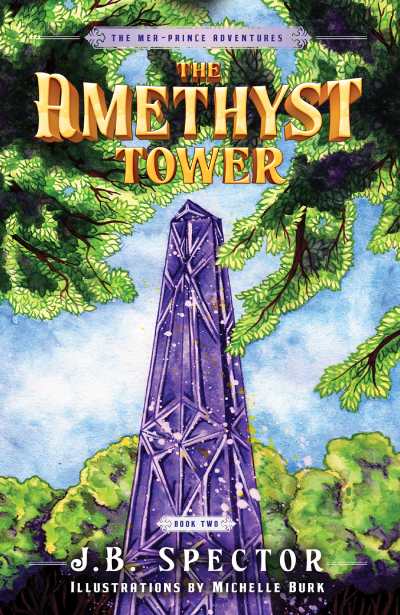
The fact that I was creating an entire world from scratch meant that I had a relatively blank canvas on which to work. So the first thing I focused on is what any culture needs in order to interact with each other: language. As your question specified, I found myself paying particular attention to the language used to tell time. I didn’t believe that there would be any reason why merfolk would use scientific terms like “seconds,” “minutes,” “hours,” etc. But they would use terms associated with something they are very familiar with—water. So I went with the smallest examples of water and I then worked my way up: a second became a “waterdrop,” a minute became a “splash,” an hour became a “wave,” and so on. I decided to let the merfolk keep the word “day” because in my writing, I found myself using the term so often that I felt it would be confusing to the reader to use a different word. So I just considered it to be coincidence that merfolk and humans in my world just happened to use the same term for a “day.” I also try to pepper into the text various ocean or water-themed terms that the merfolk use for slang or common expressions. For example, in The Amethyst Tower we learn what “whirley” means and we also learn what it means to be “grottoed.” It has definitely been fun experimenting with the language of the merfolk.
The other part of mer-culture that I wanted to explore is the one thing that all cultures have in common—food. We all have to eat, and so do the merfolk. However, I had to make a decision early on as to “Do merfolk eat fish?” In the end I decided that the answer was “no” because of one of the Laws of the Tides that states “do not kill.” I determined that the merfolk would interpret this law to also mean to not kill the fish that swim with them in the sea. So in the end, I made the entire population of merfolk vegetarians (even though I, myself, am not). I have done a considerable amount of research learning about different edible sea plants and flora whenever I’m describing a meal among the merfolk.
Systemic prejudice and unfair stereotypes are also themes throughout the series, and ones not often explored in children’s fantasy. Why did you feel this was an important element and message to include in your series?
As tragic as it is to say, systemic prejudice and unfair stereotypes exist in nearly every culture in our world. People judge others for unwarranted reasons whether it be skin color, religion, country of origin, political affiliation, body type, gender identity, etc. When I was building the world in my stories, both on land and in the sea, I didn’t want to create utopias. No culture is a utopia. Every gathering of people, from the smallest village to the largest metropolis, has its flaws, its problems, and ways that it could improve. This is true in the real world, so why wouldn’t it be true in fictional worlds? Furthermore, why would a culture of merfolk be any different? Stereotypes and prejudices are real. I didn’t want to hide from them or pretend that they don’t exist. But I also wanted to show my readers that individuals, cultures, and societies can strive to be better. I also felt that it would make an interesting plot twist that Thomas, a prince born into royalty who never wanted for anything in his life, suddenly finds himself in a class of merfolk that encounters significant discrimination and prejudice. These challenging experiences also force him to take a hard look at himself and consider how he treated the people back in his own home kingdom. But he also finds friends among the merfolk who look past the color of his tail and see Thomas for who he is on the inside. Just as I didn’t want the merfolk society to be a utopia, I didn’t want it to be a world filled with hate. Just like the world we live in today, I wanted there to be examples of kindness and equality overcoming adversity.
Another element we appreciate about the Mer-Prince Adventures is the complexity of the characters; even the villains are not wholly bereft of redeemable qualities and understandable motives. Which character do you most enjoy getting into the mind of?
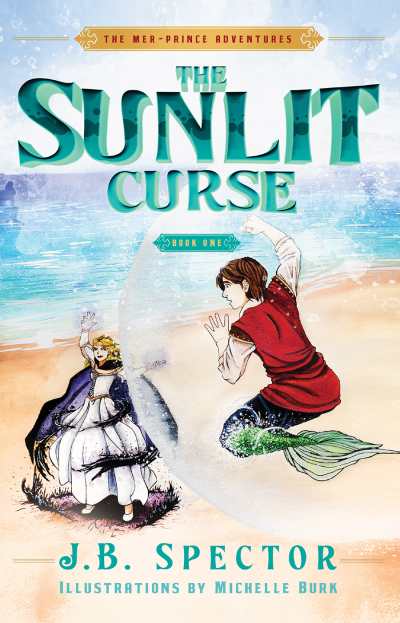
It’s interesting that you would ask me that because I was once asked which character changed the most between when I first started to write Thomas’s story and the final product. So the answer to that question as well as the one you asked are without a doubt the same answer: the antagonist, Rillana. When I first started writing this story, I was seventeen years old and a senior in high school. The story at the time was rather cookie-cutter, with black-and-white distinctions between good and evil, right and wrong, etc. This was also apparent in the character of Rillana. She was a very stereotypical villain: old and withered with age, no redeemable qualities, and basically wanting to do evil for the sake of doing evil. But as I developed as a writer, there came a point where I wanted to greatly blur the lines between those extremes. I started asking myself, “Why is Rillana doing this? What is her ultimate goal?” And I began to put more time and energy into developing her backstory and her motives. I wanted to make sure the readers still regarded her as the villain while at the same time considering that she might be doing the wrong things, but for the right reasons. I wanted readers to ask themselves how far they themselves might go to achieve such an important objective. So over the various revisions, Rillana went from being a stereotypical sea hag to being physically and mentally just another mermaid, but one who made some wrong choices in pursuit of her goal, even though the goal itself might be desirable.
The complexity of my characters is also very important to me. When I truly enjoy reading a story, it’s because I find myself feeling what one or more of the characters feel. I almost fall into the book and live through the story as one of the characters themselves. I want my readers to feel the same thing. Whether it’s the physical sensations Thomas feels during his first transformation, the curiosity that Kelda has for her new friend, or even the protective instincts of the elders of Meramor, I want my readers to fall into my books just like I do with other books. To that end, I try to make my characters as relatable as possible. I want my characters to come alive in the minds of my readers so that some young boy or girl out there might one day say, “Boy I really wish I could meet Thomas and Kelda!” Maybe that’s the dream of every author out there, but I know that it sure is a dream of mine.
Is there anything you’re working on right now that you can tell us a bit about?
Well, I am currently working on book three of The Mer-Prince Adventures. It’s called The Coral Castle and I must say that I am excited with what is already in the manuscript as well as where it’s heading. We finally get to see what this game “Uprush” is all about that Kelda raves about in book two, we get to finally meet King Marenki, and Thomas’s birthday is just around the corner. The story moves full-steam ahead in book three, and I can’t wait for my readers to find out what happens. Unfortunately, the manuscript is still in progress so I don’t have a tentative release date as of yet. But my readers can follow my Facebook author’s page for any updates or news. My books are currently available on Amazon in both print and Kindle versions, and they are Prime and Kindle Unlimited eligible.
Thank you so very much for this opportunity to speak to your readership and I hope they enjoy joining Thomas on his adventures both on land and in the sea!
Barbara Hodge
